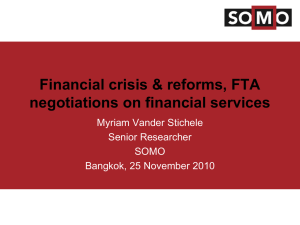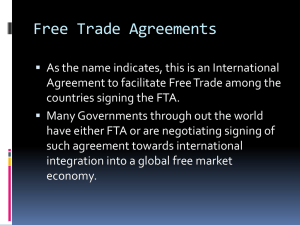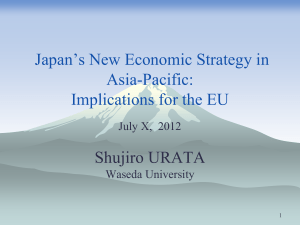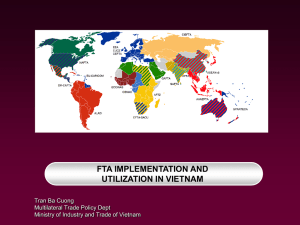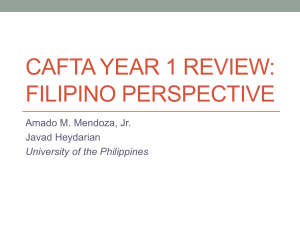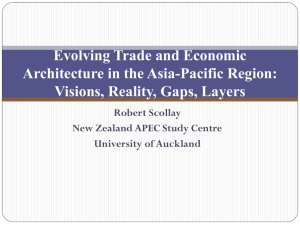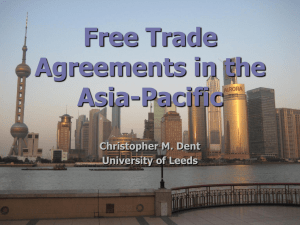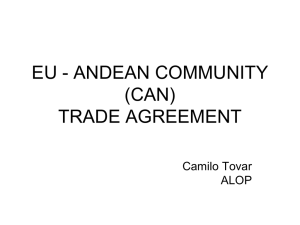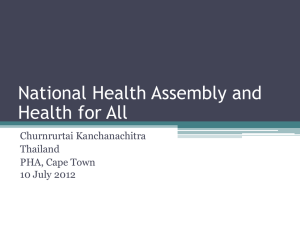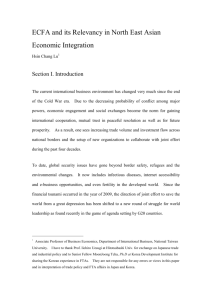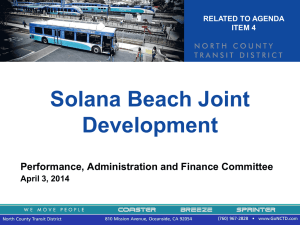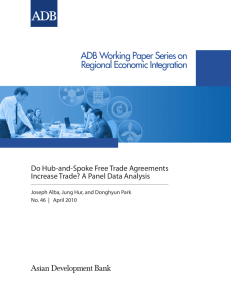Maximising the benefits of FTAs in Asia
advertisement
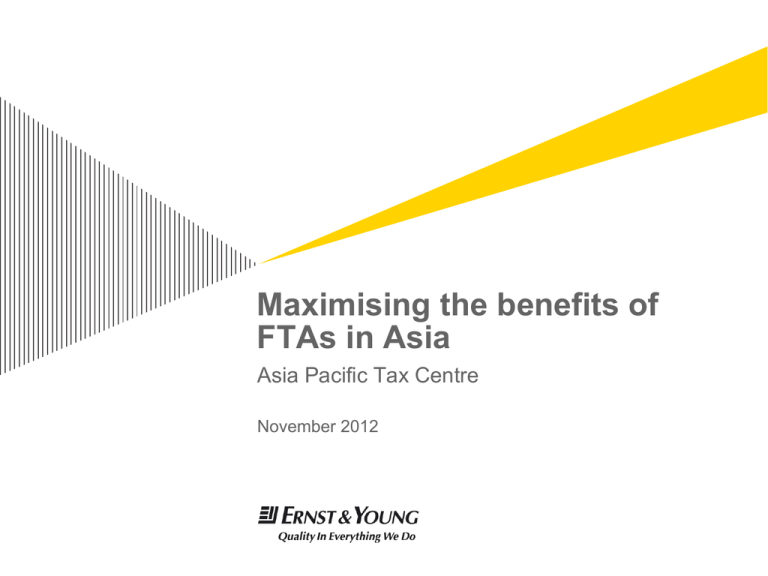
Maximising the benefits of FTAs in Asia Asia Pacific Tax Centre November 2012 Agenda ► ► ► ► Recap on FTAs & key features New Zealand’s FTA coverage + insight on CN & ASEAN Progressive FTA benefits Optimising value from FTAs ► ► ► ► Identifying benefits and “quick wins” Progressive benefits - interaction with supply chain optimisation Supply chain impact: examples Lessons learned ► Page 2 Strategic sourcing, realignment of substance Maximising the benefits of FTAs in Asia Focus of today’s session ► Key aims: ► ► ► ► ► Evaluate how FTA benefits can be claimed Explain the impact of FTAs through the supply chain Evaluate opportunities to maximise FTA benefits Examine opportunities to add incremental benefits Key learning: ► Page 3 How reviewing FTA claims in conjunction with supply chain planning can drive optimal value Maximising the benefits of FTAs in Asia Key features of FTAs in general ► General features of FTAs include: Feature Summary considerations Impact Rules of Origin ►ROO must be met to claim preferential duty rates – in general: ►“Wholly obtained” (resources) or “substantial transformation” (manufactures) ►“Substantial transformation” if transformed into new good by manufacturer – ►(1) Value Added Rule (2) Change in Tariff Classification (3) Process Rule ►Accumulation principle important in multi-stage value chain High Admin issues ►Significant – main requirement often is obtaining certificate of origin (COO) ►COO is issued by authority of exporter but benefits borne by importer ►Generally, must prove compliance with ROO to obtain High Direct shipment ►Generally, delivery must be direct between member countries to obtain benefit ►Transit allowed in some cases Med Third country invoicing ►Goods Med Page 4 shipped between two Members, but invoiced through a third country ►Most FTAs do not prohibit this, but “silence” risks prevention of FTA benefits Maximising the benefits of FTAs in Asia Summary of key New Zealand FTAs And a comparison between ASEAN-China ► Key features of New Zealand’s key FTAs are as follows: ANZ-ASEAN NZ-China ASEAN-China ROO (differs per product) ►Accumulation principle ►Co-equal approach (tariff change or value add w. 40% FOB threshold) ►Reduced red tape ►Transit allowed ►Accumulation principle ►Tariff change or value add w. 40% FOB threshold ►Reduced red tape ►Transit allowed ►Accumulation Admin ►COO, ►COO ►COO simplified procedure (but not on CN principle ►Tariff change or value add w. 40% FOB threshold ►Reduced red tape ►Transit allowed import) Benefits ►Accumulation principle ►Eliminates 90% of tariffs ►Liberalised trade / access ►Investor protection ►Facilitate goods movement ►Eliminates 96% of tariffs to 2019, inc. key exports ►Increased cooperation ►Investor protection ►Liberalised trade/access ►“Normal” Overall ►High ►Medium/High ►Medium Page 5 benefit benefit Maximising the benefits of FTAs in Asia vs. “sensitive” ►Normal duties almost eliminated ►Liberalised services trade ►Greater investor protection benefit Optimising FTA benefits through the supply chain – three tiers 1. Quick wins 1 Claim FTA benefits 2/3. Supply chain restructuring 2 Strategic sourcing 3 Supply chain optimisation Benefit Map FTA benefits with current flows to claim FTA benefits Map potential FTA benefit with strategic sourcing opportunities Restructure supply chain to optimise FTA, tax and operational benefits Complexity and implementation challenges Page 6 Maximising the benefits of FTAs in Asia 1. Quick wins - claiming existing benefits Mapping supply chain flows and claiming FTA benefits 5-point process to evaluate, apply and obtain strategic FTA benefits: ► 1. 2. 3. Identify FTA coverage based on current supply chain product flows Ascertain overlaps between FTAs for these flows Evaluate the respective benefits of the FTAs, including overlaps (see table below) ► 4. 5. Including duty, market access, relaxed ROO / qualification, reduced admin (may conflict) Make application Ongoing management/administration of the process Multilateral and bilateral agreements with ASEAN SG TH MY Bru. ID PH VN CM LA MM AU AANZ AANZ AANZ AANZ AANZ AANZ AANZ AANZ AANZ AANZ AANZ TPP TPP TPP BL BL ► ► ► Page 7 TPP BL AANZ: ASEAN: TPP: BL / SP: TPP BL Australia & New Zealand FTA Trans Pacific Partnership Bilateral Maximising the benefits of FTAs in Asia US CN TPP Peru Chile TPP TPP BL Bilateral only for CN 1. Quick wins – other concerns ► Examples in evaluating the benefit include: Question Summary considerations If multiple FTAs, which to claim? 1. 2. 3. Concerns outside of duty rates 1. 2. 3. Services or investment flows 1. Other provisions? • ► 2. Differs based on type of product, service or investment flow E.g. bilateral tariffs may be lower than ASEAN-ANZ for NZ exports to ASEAN Not only the tariff is important: must evaluate whole package Variance of ROO between parties, self-declaration Special measures for certain products (e.g. textiles, clothing, agriculture) The existence or removal under the FTA for non-tariff barriers “Negative list” under the TPP – beneficial for services …but no investment chapter in TPP Competition policy, IP considerations – NZ FTAs affirm multilateral obligations in this area But challenges remain: ► ► Page 8 Complexity of ROO requirements, admin process and duration for COO Full awareness of benefits available Maximising the benefits of FTAs in Asia 2. Opportunities through supply chain restructuring ► Assuming claims are both possible and feasible: 1. 2. ► Could the product flow or supply chain footprint be changed to maximise FTA benefits? How may FTA benefits be enhanced by operational and tax savings? Two major opportunities to enhance existing potential FTA benefits 1. Strategic sourcing 2. TESCM planning Concept 1. Evaluate alternative raw material supplies to maximise FTA benefits 1. Full supply chain restructuring including FTA benefit optimisation Applies 1. All NZ importers / exporters 1. All companies – discrete or full scale Process 1. Spend and FTA analysis, full cost / benefit evaluation and implementation 1. 5-stage process: opportunity assessment, feasibility, design, implementation, sustain Example 1. NZ importer of raw materials Sources currently from Europe at 10% Changes to MY, claims treaty benefits Reduces duty to 0% for this product 1. NZ domestic value chain, goods exporter Sets up MY manufacturing, procurement FTA benefits claimable on purchase/sale Tax/operational benefits added 2. 3. 4. Page 9 2. 3. 4. Maximising the benefits of FTAs in Asia 2. Strategic sourcing process Identify savings opportunities Strategic sourcing 1. 2. 3. 4. 5. Undertake full spend analysis Identify quick wins Select priorities Benchmarking Blueprint Recommend ways to Full evaluation 6. Supplier selection Realise savings 7. Final analysis Realise savings 8. Negotiate per blueprint Realise 9. Claimsavings FTA benefits Project enablers Analysis Definition Transition Examples where strategic sourcing may apply: A. Import of raw materials to NZ manufacturing site B. NZ co with ASEAN or CN manufacturing presence, buy/sell from region C. NZ co with ASEAN or CN manufacturing presence, buy/sell from NZ (NZ materials export) Page 10 Maximising the benefits of FTAs in Asia 2. Option A – changing the source of imported materials 1. 1 NZ co with domestic manufacturing, source overseas & import to NZ 1. Goods for import currently sourced from EU 2. Evaluation of potential suppliers undertaken 1. EU 2. 3. Product characteristics / quality Benchmark costs FTA benefits mapped indicate overall cost advantages, 1. 2. Net of quality and FTA benefits Full costs included in review New flow Existing Flow Page 11 Key Plants R&D Maximising the benefits of FTAs in Asia Distribution Sales HQ 2. Option B – changing the source of imported materials to overseas location 1. 2 NZ co with ASEAN or CN manufacturing presence, buy/sell from region 1. Goods for import currently sourced from EU 2. Similar to A, evaluation of potential suppliers undertaken 1. EU 2. 3. 3. Product characteristics / quality Benchmark costs FTA benefits potential Net cost benefits, as before 1. 2. Differing FTA arrangements Origin rules on further manufacturing & supply key Future flow Existing flow Page 12 Key Plants R&D Maximising the benefits of FTAs in Asia Distribution Sales HQ 2. Option C – increased export opportunities for NZ companies 1. 3 Independent co with ASEAN manufacturing, buy/sell from NZ 1. Goods for import currently sourced from EU 2. Opportunities for NZ exporters to maximise access to ASEAN 1. EU 3. Importer can also benefit from reduced duty, accumulation rule Net cost benefits, as before 1. 2. Note admin requirements for NZ exporter, but benefit in importer Main benefit to exporter is increased scale through access Future flow Existing flow Page 13 Key Plants R&D Maximising the benefits of FTAs in Asia Distribution Sales HQ 3. Case study (1/3): incremental benefits through supply chain planning ► Supply chain planning can drive incremental benefits on FTAs ► ► ► 1.NZ co with MY manufacturing presence, SG buy/sell procurement in a “Supply Chain Principal” Operational benefits through more effective operating model Tax benefits through incentives, substance Fact pattern: ► ► ► Procurement operations converted to centralised model (in Singapore) Manufacturing in MY converted to contract Entails functional shift to SG site ► ► ► ► ► ► Page 14 Demand aggregation Supplier identification Negotiation, potentially contracting Supplier management Supply chain planning, manufacturing strategy Inventory ownership, management Maximising the benefits of FTAs in Asia Sourcing Sale to manufacturer Sale to customers Accumulation benefit on sale of processed goods from MY ► Export still qualifies for ANZ-ASEAN FTA preference – 0% duty Medium ► Supplier identif ication ► Demand aggregation and f ramework agreements ► Supplier management and development Sourcing company 4. 5. Goods to not enter SG, but 3rd country invoicing allowed Tax incentives on centralised procurement in SG and manufacturing functions in MY Import and export company Full Principal with intellectual property Sales and marketing Principal Plus ► Sales and marketing strategy ► Pricing policies Plus ► Logistics management ► Import and export processing ► Freight f orwarding Service company Business impact High ►Must carefully review differences in ROO / accumulation of benefits ►Careful planning essential: switch sale/trade may be insufficient to claim ROO in other examples Further operational benefits Page 15 Plus ► Brand management Supply chain management company ► Contracting Low 3. Plus ► Supply chain planning ► Inventory ownership and management ► Manuf acturing strategy ► Research and development strategy ► Negotiation Low 2. FTA benefits claimable on import of raw materials to manufacturer – 0% duty Benefit 1. High 2. Case study (2/3): key features and benefits Maximising the benefits of FTAs in Asia Case study (3/3): tax incentives – further adding to the potential benefits ► ► ► Centralised procurement and manufacturing operations in ASEAN country (Singapore in this example) Incremental tax benefits, adding to FTA and operational benefits, through tax incentives Including Singapore, example incentives include: Singapore Thailand ► Board Incentive type ► IHQ or RHQ (DEI incentive) ► Global Trader Program of Investment (BOI) inc. ► International Procurement centre ► Tax Typical benefits rate potentially to below 5% ► Up to 10 years (5 + 5) ► Spend, Conditions Page 16 headcount, functions, product, industry, etc ► Potential tax exemptions (BOI) ► 15% tax rate (IPC) ► 200% R&D deductions ► Location, spend, turnover, and other criteria Maximising the benefits of FTAs in Asia Malaysia ► Pioneer status ► Investment tax allowance ITA ► Partial or full tax exemption (Pioneer) ► Enhanced tax allowance (ITA) ► Up to 10 years ► Product, industry, spend, technology Key lessons learned ► FTA benefits can be extensive, if claimed ► These benefits can be enhanced by tax and operationally effective supply chain planning ► Strategic sourcing in a centralised procurement entity is one example of this: ► ► There are several others Care should be taken to analyse ROO, admin requirements and other key factors: ► Page 17 Common experience is that admin burden is extensive and the rules are complex Maximising the benefits of FTAs in Asia Questions Page 18 Maximising the benefits of FTAs in Asia Thank you
